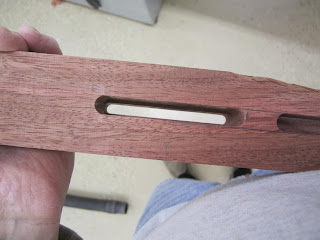Rails: The joinery for the back rail is straight forward. Here is the rail cut to length with the tenon locations penciled at the end (they are 1/2" thick and 5/8" long tenons):
The ruler above shows the cant angle for the rear posts - about 2 degrees. Now, that cant angle is important for when I cut the side rail tenons. At this time I will rip a thick piece of scrap wood with one side cut at the same cant angle. Below is a shot of the rear rail next to the saw blade angled with the cant angle.
Below is the end view of the scrap wood ripped with one side cut at the cant angle:
Now, this scrap wood was milled to the same width as the side rails. We will come back to this scrap wood shortly. We will be using it to cut the tenons for the side rails.
However, back to the rear rail. I did not take any photos cutting the rear rail tenons. In a nutshell, I used the multi-router. I also used the multi-router to cut the 1/4" mortises for the plethora of splats. Then I took the rear rail to the bandsaw and cut the back decorative profile followed with a file, shoulder plane, and sand paper for cleanup:
Now to the side rails. These will be more complicated! The side rails will have a compound angled tenon in the back and angled box joints up front. The tenons will be compound angled because the side rails splay outward and the rear posts have that 2 degree cant angle as well.
Using my drawing, I determine the splay angle and the corresponding angle required to cut the end of the front rail:
I cut the rails to length with the front angled:
Ok, here comes the tricky part. The tenons in the rear of the side rails must be accurately laid out! To lay out compound angle tenons it is important to start at the top shoulder and work around. For straight tenons we normally layout the tenons at the end of the rail. But for angled tenons we start at the top shoulder.
From there I mark out the end of the tenon using a bevel gauge adjusted to the cant angle, careful to distinguish left vs right rail:
Then I mark out the bottom of the tenon:
Now, do you remember that scrap piece of wood we ripped earlier that is the same width as the rails with one side cut to the cant angle? Now is the time to use it:
In the photo above we see the rail on top of the scrap wood. I glued on 1/4" plywood to the sides. The side that was ripped at the cant angle is facing down (important!). What that scrap wood does is tilt the side rail so that the angled tenon is no longer angled but rather parallel to the table surface (or what ever surface - such as a table saw fence). Also note that to cut the other rail one will use the other side of this scrap wood so the angle is reversed for the other rail's tenon.
Now I take the whole assembly to the multi-router. The multi-router table is tilted to the splay angle of the rear rails which defines the second angle of the compound angled tenon. Note that one could use a table saw or bandsaw here with an angled blade and ride the assembly against the fence
Now, before cutting the real tenons, I used a test piece to set my mulit-router end stops for the tenon thickness. I first cut the whole tenon to 3/8" thickness and test the fit in a scrap piece with a 3/8" thick mortise.
Then I define the two 1/4" through tenons and then test that fit in a mortise that has both the 3/8" thick part and 1/4" part:
Once I'm satisfied I cut the real McCoy. Since I will be inserting wedges into the through tenons I need to taper the end of the mortises in the rear post. I usually go out 1/16". That is the gap you see above and below the through tenons in the photo below.
Here is the chair assembly dry fitted (note that the rear posts appear heavily angled but this is due to the wide angled camera lens):
The box joint ends will stick out about an 1/8". I layout the box joints on the side rails and front rail using a caliper:
When cutting the box joints I did not use a box joint jig. I simply cut the side rail box joints to the pencil line then cut the front rail box joints using trial and error with a test piece for fitting. I used the multi-router since I had the table all set up with the proper splay angle for when I had cut the tenons earlier. The router bit also left a very nice bottom. A dado blade would suffice but dado blades tend to leave rabbit ears. (One of these days I'd like to get a box joint cutting blade with a flat top).
I got all the joints fitting well except for one (there is always that one!). I glued on a shim and tried once more:
I then beveled the ends of the box joints. I used a file. One thing to note about this piece. Traditional Greene & Greene furniture uses a lot of heavy round overs. I am breaking from tradition here using very light round overs and beveled edges. Just for the hell of it.
Good time to call it quits. Now, where did my wife hide the Halloween candy...






























LOL! Lookin' really nice and difficult to do, but well done. That multi router table is quite the contraption. But it just needs to do the job, right!?
ReplyDelete